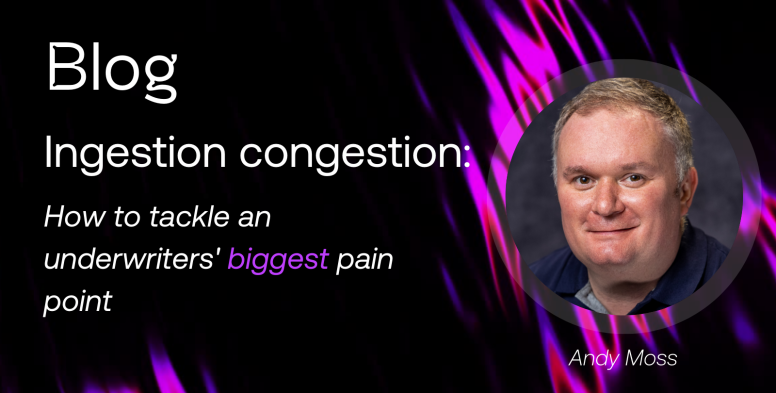
It’s one of the biggest pain points facing underwriters: how to tackle the overwhelming influx of submissions and cut through the noise of unstructured data to focus on the most profitable risks.
This was an issue brought into sharp relief during one of the panel sessions at the Intelligent Insurer event, Underwriting Innovation Europe. One of the questions posed by the audience during a session titled “The courage to implement change, what underwriters can be doing to brace for the future?”, was “What would you like to change first, and how will your teams respond?”
The answer from panellist Mandy Hunt, the CUO, Commercial Lines at RSA was crystal clear:
“We spend too long manually sifting through broker presentations. How can we ingest quickly, and have tools that can read the presentations, pick out the right stuff and give underwriters something to start with?”
Mandy qualified this by reminding the audience that iterations of this type of automatic functionality are already available elsewhere. She’s right of course, underwriters, and particularly younger talent, expect a superior level of functionality in their work lives that mirrors the processes they use at home.
When we buy online or need to fill out digital forms, our data is already pre-populated in fields, cutting down on the time we need to spend on this manual activity. Most versions of Outlook now automatically sort our ‘focused’ emails into a separate stream, with everything else heading straight to “other”. Automated sorting and AI is playing a bigger part in our everyday lives and there is a huge opportunity to apply a similar approach to how we manage submissions with the technology available.
It wasn’t just Mandy who raised the issue though. Ben Cannon is the Underwriting Manager, General Aviation for Allianz Global Corporate & Specialty, in a later panel debate, he reiterated that the initial submission and assessment of presentations is very manual.
Underwriters have to do their due diligence, manually assess coverage and gather additional information from brokers, he summarised:
“We’re looking at a very slow process, all manual, which slows response times and can lead to inconsistencies.”
In the same session, James Anderson, a partner at EY highlighted that we’ve ended up with highly talented, highly paid people working on data entry. Another panelist, Christine Kaaz, CUO at ERGO, likened submission to the recent movie “Everything, everywhere, all at once.”
This is just a small selection of very senior insurance leaders all struggling with the same challenge, it’s also something we repeatedly hear from our customers; underwriters are crying out for a solution to ingestion congestion.
Why now?
Underwriting is an age-old profession, but what is driving the current dissatisfaction with how the process works?
In years gone by, email and spreadsheets were the smart, efficient way of transferring information, before these innovations, there was the even more manual process of submitting written information, physical forms and slips of paper
For a while, it felt like we had the process nailed. But over recent years, the increased availability of data from multiple sources has reached levels that have become unmanageable for underwriters.
Underwriters need to be using more data points to create a competitive advantage, but they are now spending a significant portion of their day wading through email submissions, manually extracting data from spreadsheets, and PDFs and making judgment calls on what they should focus on
They’re also under increased pressure to perform this task quickly and more efficiently than ever; in a tough market, businesses need to work smarter, not harder.
Is there a Smart solution?
The pre-bind process is ripe for automation, and the technology is available to help underwriters to manage their submission with the support of generative AI.
We recently launched our own solution to this challenge, our Smart Submission component, which can either be seamlessly integrated into our own Underwriting Workbench or connected via API to an underwriters’ existing platform of choice.
Smart Submission uses Open AI to provide intelligent automation that extracts data from email in seconds. Submissions to the Smart Submission Inbox are rapidly and automatically ingested, classified and triaged, freeing up underwriters to spend more time assessing more valuable risks and improving their submission-to-quote ratio.
To try and mitigate the often-inevitable back and forth with brokers, and the desk-based research that underwriters conduct to find out all the information they need on a risk. Smart Submission uses data enrichment to gather as much useful data as possible, helping underwriters to make more informed decisions. The component even sends risks to a triage board when further action needs to be taken, allocating tasks for review in order of priority
We see Smart Submission as a clear example of how generative AI and automation can be deployed to greatly enhance an underwriter’s experience as well as drive tangible benefits. We don’t want to see talented underwriters crumbling under the weight of submissions, we want to set them free to do more of the work they love!
If you’d like to find out more about Smart Submission, please get in touch to arrange a chat or a demo.
Author: Andy Moss, co-founder and CEO.